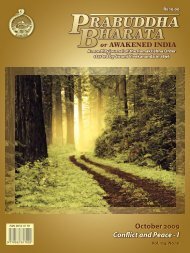P
PB Cover July 2011.indd - Advaita Ashrama
PB Cover July 2011.indd - Advaita Ashrama
- No tags were found...
You also want an ePaper? Increase the reach of your titles
YUMPU automatically turns print PDFs into web optimized ePapers that Google loves.
Mexico Rising: The Gods Are Alive 37<br />
PB July 2011<br />
once pointed out that the skulls around Mother<br />
Kali’s neck seem to be smiling. The skulls also<br />
symbolize our egos. When Mother cuts our ego,<br />
all tension is gone. Mother Kali wears a skirt of<br />
severed arms that represent our actions. While<br />
we are entitled to work, the result of our work<br />
belongs to her.<br />
The middle portion of Coatlicue’s body, from<br />
her skirt down to her feet, represents the underworld.<br />
Her feet are eagle claws that can dig into<br />
the earth and aid in agriculture. Underneath her<br />
serpent skirt, out of the maternal uterus, comes<br />
a serpent giving birth to the sun god named<br />
Huitzilopochtli.<br />
According to the legend, Coatlicue was<br />
sweeping on top of Coatepec, a mountain of<br />
serpents, when she found a package of feathers.<br />
She hid the feathers under her skirt and shortly<br />
after found that she was pregnant with Huitzilopochtli.<br />
Her daughter, the moon, and her sons,<br />
the four hundred stars of the south became jealous<br />
and decapitated her. But she did not die<br />
because Huitzilopochtli protected her. Born a<br />
fully-grown man in a magical birth, Huitzilopochtli<br />
in warrior mode decapitated Coyolxauhqui,<br />
the moon, and cut off her arms and<br />
legs—hence the moon is round. ‘The sun takes<br />
over the moon in order to give life to Mother<br />
Earth,’ said Angel. ‘Light overcomes darkness.’<br />
Angel took me behind the statue of Coatlicue<br />
and pointed to a stone leaning against the pedestal<br />
the goddess stands on. This stone, which<br />
encompasses the soles of Coatlicue’s feet, depicts<br />
a fourth universal plane—heaven and earth, and<br />
the underworld being the other three. It depicts<br />
the union of Tlaloc, the god of water and rain,<br />
and Tlaltecutli, a sea serpent that is an embodiment<br />
of raging chaos before creation. Between<br />
them a round shield and a square within portrays<br />
the earth with its four cardinal points of<br />
north, south, east, and west. The earth—also represented<br />
by Tlali, Chimalma, and Tonantzin—is<br />
shown within as a circle.<br />
‘Long before Europeans, the ancient people<br />
of Mexico had the knowledge that the earth was<br />
round,’ said Angel.<br />
I asked, ‘What happened? Why do people in<br />
Mexico no longer worship Coatlicue?’<br />
‘We’ve passed through a transition from a<br />
pre-Hispanic to the modern era,’ said Angel.<br />
‘After Coatlicue, the mother of Aztec gods, came<br />
Chimalma, the circular earth; then Tonantzin,<br />
mother of gods and humans; and then the Virgin<br />
of Guadalupe.’<br />
I was busy taking photographs of Coatlicue.<br />
The museum kindly allows photography provided<br />
one does not use flash. When I turned<br />
around, Angel was gone. He was gone so<br />
abruptly that I questioned in my mind whether<br />
he was real or not. Was he a physical form of the<br />
voice in my head I heard in the morning? He<br />
came quickly, gave me wise explanations, and<br />
then he was gone. I would have liked to ask him<br />
more about the goddess Tonantzin, who used to<br />
be worshipped on the hill of Tepeyac where Our<br />
Lady of Guadalupe first appeared.<br />
Although I had the best intentions to go<br />
straight to the Basilica of Our Lady of Guadalupe,<br />
fate had other plans. I was taken outside<br />
Mexico City to Teotihuacan, a vast archaeological<br />
site with a soaring sun pyramid and a<br />
huge moon pyramid linked by the wide Avenue<br />
of the Dead. Some scholars estimate that this<br />
city may have been established around 100 bce<br />
and that by the fourth century some 200,000<br />
people lived there. The city covers nearly eight<br />
square miles and was larger and more advanced<br />
than any European city of the time.<br />
Still, to this day, Teotihuacan is shrouded in<br />
mystery, and nobody truly knows who founded<br />
this city—be they the Totonacs, Otomi, Zapotec,<br />
Mixtec, Maya, or Nahua peoples. Archaeologists<br />
497
















